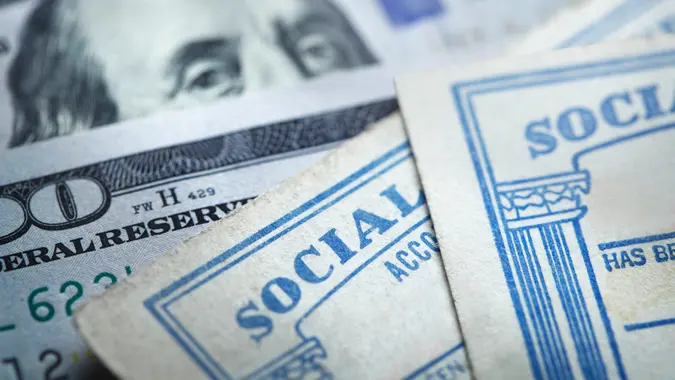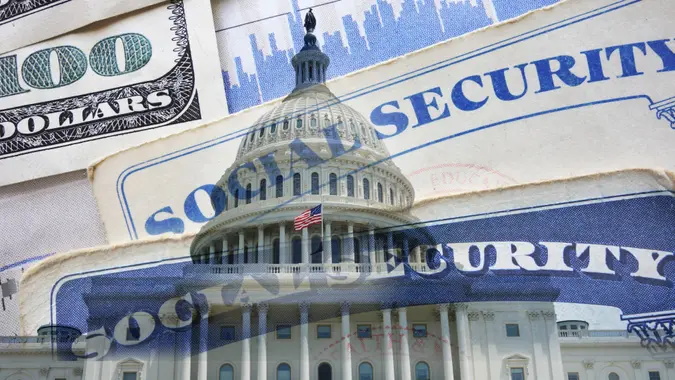Social Security: Could the Unpopular Opinion That the Program Needs To Be Cut Hold Weight? Here’s What Data Shows

Commitment to Our Readers
GOBankingRates' editorial team is committed to bringing you unbiased reviews and information. We use data-driven methodologies to evaluate financial products and services - our reviews and ratings are not influenced by advertisers. You can read more about our editorial guidelines and our products and services review methodology.

20 Years
Helping You Live Richer

Reviewed
by Experts

Trusted by
Millions of Readers
One of the main arguments for cutting Social Security benefits, or at least aggressively reforming the program, is that it cannot sustain itself financially under the current system.
A major funding source — the Old Age and Survivors Insurance (OASI) Trust Fund — is expected to run out of money within the next decade. When it does, Social Security will have to rely on payroll taxes for funding, and those currently cover only about 77% of benefits.
Meanwhile, the number of people working and contributing to the system can’t keep pace with the number of retirees getting benefits — especially as life expectancy rates continue to rise.
There are three basic schools of thought on how to fix the program. You can either bolster it through higher payroll taxes, raise the retirement age to discourage people from filing for benefits early, or cut the monthly benefits retirees receive.
The last idea is wildly unpopular, but it does have its defenders — and not just among fiscal hawks who want to cut all kinds of government funding. Even people who might normally be considered progressive say that Social Security needs to be reformed now to ensure that future generations can benefit from it.
Part of the reasoning behind changing the system is that people are living longer than they did when Social Security was established nearly 90 years ago. This means the program must pay benefits to an ever-rising population of seniors.
A recent essay in The New York Times addressed this issue, noting that older Americans are “consuming an ever larger share of our economy’s resources through programs like Social Security and Medicare, leaving younger Americans to foot growing bills for their parents’ and grandparents’ retirements.”
The essay was co-authored by C. Eugene Steuerle, a former U.S. Treasury official who co-founded the Urban-Brookings Tax Policy Center; and Glenn Kramon, a former New York Times editor who now lectures at Stanford Business School. Both are in their 70s.
According to their research, for a typical couple with two 65-year-olds, at least one will likely make it to 90 or beyond based on current averages.
“Yet even as life expectancy has risen since 1935, the minimum age to qualify for at least a portion of your Social Security benefits has fallen to 62,” the essayists wrote. “That means that many people are now drawing from Social Security for as much as a third of their adult lives, if not more. If people took the same number of retirement years as the average person retiring in 1940, they would stop working at around 77.”
The result is that Social Security is “increasingly losing its purpose as old-age insurance” and “older Americans are taking far more out of the system” than they paid in.
“Consider how much lifetime Social Security and Medicare benefits have grown,” Steuerle and Kramon wrote. “For a typical 65-year-old couple, those benefits, adjusted for inflation, are worth over $1.1 million today, compared with $330,000 in 1960. Benefits rise as each generation lives longer and receives amounts that grow with the cost of living and as medical prices rise and expensive medical treatments proliferate. Yet the lifetime taxes this couple pays into Social Security and Medicare amount to about $650,000.”
At the same time, the number of people available to pay for each retiree’s benefits is dwindling, according to Steuerle and Kramon: “Declines in birthrates and, at times, immigration rates, have helped lower the ratio of covered workers to beneficiaries, from 4.0 in 1965 to 2.7 today, with 2.3 projected in two decades.”
A separate NYT column, published last week, noted that “a lot of tax dollars are going to finance the lifestyles of some retirees who really don’t need the money. Rightly or wrongly, Congress is choosing spending on the old over spending on the young.”
This is not a problem that has gone unnoticed in the nation’s capital.
“Nearly everyone in Washington, Democrat and Republican, socialist or MAGA, is aware that withdrawals from these programs exceed the money being put in,” Steuerle and Kramon wrote. “They are just too scared to do anything about it.”
One suggestion is to redefine “old age” to reflect longer lifespans and then adjust the nation’s retirement expectations — along with programs that fund retirement. This might involve raising taxes, cutting benefits, or both.
But there’s also another remedy — having people delay retirement and raising the age at which they can get Social Security retirement benefits.
“Those in late middle age will need to work longer as they live longer,” Steuerle and Kramon wrote. “That would help shore up revenue with additional Social Security taxes and the income taxes that largely pay for Part B of Medicare. It would also reduce pressure to cut benefits for the oldest of the old… We can both increase revenue and reduce spending by increasing the earliest retirement age from 62 and the full retirement age from 67.”
More From GOBankingRates
 Written by
Written by 
























